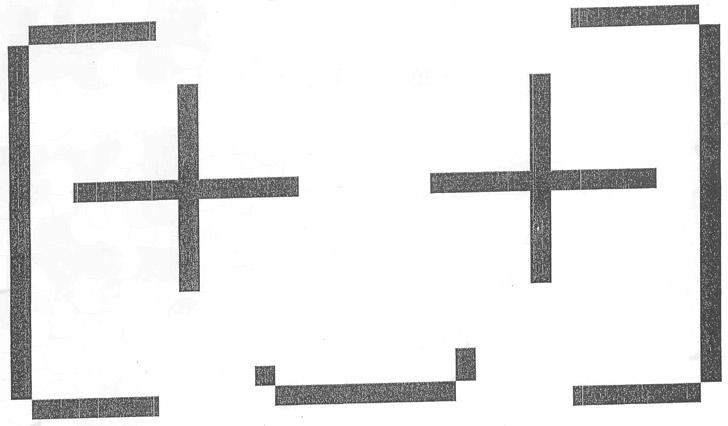Digital Discipline: Minimalism in House and Techno. IV
By Philip Sherburne – Published in Christoph Cox and Daniel Warner, Audio Culture: Readings In Modern Music, 2004
On the one hand, there’s the stripped-down lucidity of Daniel Bell’s work as DBX, in which he crafted tracks so deliriously spare as to be almost physically disorienting – with nothing but the barest of percussion lines and an eerie, disembodied voice, it becomes difficult to orient oneself in space or in time. (Not insignificantly, Richie Hawtin’s third album as Plastikman, 1998’s Consumed, which built upon Bell’s ultra-minimal foundation, derived from Hawtin’s experience of utter darkness in Canada’s northern wilderness.) On the other hand, the polyrhythmic chaos of a track like Robert Hood’s “Make a Wish” suggests the density achieved in Reich’s most rhythmically convoluted works.
Skeletalism is the teleological impulse driving early Chicago house, acid, and Detroit techno to continually do more with less, and it is the defining principle behind the late 90s “clicks and cuts” school to approximate the form of dance music by substitution and implication, swapping out traditional drum samples for equivalent sounds sourced from pared-down white noise: click, glitch, and crackle. Skeletalism is the sound of DBX’s preludes for thump and bleep; it’s the sound of Richie Hawtin’s bassy, darkly droning mantras; it’s the sound of M:I:5’s curious collisions of overdriven bass, snare, and guitar samples, which attempt to obliterate white space with bleeding distortion, but still leave the silence between the notes yawning ominously as seismic fissures. Skeletalism almost certainly finds its apogee in Thomas Brinkmann’s experiments in abbreviated form, in which techno’s essential form is carved, literally, by cutting vinyl records with a knife and then sequencing the sampled clicks and pops into rudimentary 4/4 pulses.
It is less apparently minimal than skeletalist tracks, even if it accomplishes its means with few more resources. In the early years of the 21st Century, massification has tended to be the more dynamic area of exploration. Its most distinctive exponent is probably the Chilean/German producer Ricardo Villalobos, whose training in Afro-Cuban percussion has led him to a practice that aims for maximum rhythmic density using only a handful of discrete sounds. Tracks like “Bahaha Hahi” and his remix of Monne Automne’s “El Salvador” submerge techno’s all-important downbeat in a roiled sea of offbeats and glancing accents, resulting in a woozy continuum as predictably unpredictable as the surface of choppy water.
Ricardo Villalobos – Bahaha Hahi
After all, drum’n’bass has kept to the same strategies of repetition, if anything restricting its musical subject matter even more severely by relying extensively on only a handful of classic breakbeats like the famous “Amen” break, which comes from The Winstons’ 1969 tune “Amen Brother.”
Techno’s minimalism resonated more with movements in visual art that emphasized cleanliness of form and a minimum of affect. Minimalism, as a catchword, has come to embody a skeletalist prejudice. Drum’n’bass, on the other hand, is one of the most “maximal” forms of music out there. In its galloping tempo, its surging waves of bass, and its macho rage, it is all about affect. Minimalism as popularly conceived, then, applies a certain stone-faced (as opposed to screw-faced) poise. This might explain the rise of post-techno minimalism of the Clicks + Cuts series – in the context of a specific class – well educated, enamored with theory, and generally employed in the information economy – minimalism in its most ascetic form fit the day’s prohibition on emotion, favoring poise over passion.
Skeletalism is also the watchword in current strains of UK garage (a mid-tempo hybrid of house and drum’n’bass). After several years in which UK garage aimed to reconfigure pop and R&B in line with its idiosyncratic rhythms, producers of the so-called “grime” or “sublow” school – Dizzee Rascal, Wiley, Plasticman, et al – have stripped away all but the fuzzy bass and overdriven snare drums from their tunes, leaving wide swaths of empty space between the beats. On the surface, this has as much to do with the rise of the MC in UK garage as any tendency toward silence for silence’s sake: essentially the UK’s first indigenous manifestation of hip hop, garage has become the underpinning for a new generation of vocalists rattling off double-time chatter, sometimes composed and sometimes improvised, combining U.S. and Jamaican styles. But U.S. hip hop has always managed to find room for vocalists and busy beats alike, and so it’s impossible not to suspect that garage’s newfound leanness has as much to do with its producers’ economical infatuations as it has with more utilitarian purposes. Once again, a dance music form – a form with all the opportunities that technology affords to cram every space with sound – has gone anorexic.
The trend seems almost a given. But then again, considering garage’s lyrical turn, one wonders if
When machines (both hardware and software) can cram every nanosecond with noise, is the last refuge of humanity to be found in space, in restraint, and in silence?
The End
Posted in academia on October 6th, 2008 by fresh good minimal | 2 Comments










 gmail
gmail com
com
